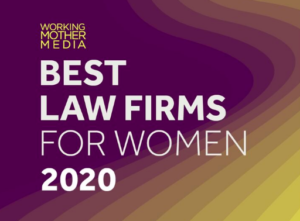Congratulations to all the law firms named to Working Mother Media’s 2020 Best Law Firms for Women List. These firms are being recognized for their “efforts and successes in finding, retaining and promoting women lawyers” and we commend their commitment to gender parity.
 The Best Law Firms for Women List has been published for the last thirteen years. Law firms are asked to complete an application including more than 300 questions about attorney demographics at different levels, schedule flexibility, paid time off and parental leaves, and development and retention of women.
The Best Law Firms for Women List has been published for the last thirteen years. Law firms are asked to complete an application including more than 300 questions about attorney demographics at different levels, schedule flexibility, paid time off and parental leaves, and development and retention of women.
We are particularly proud to congratulate the following Diversity & Flexibility Alliance members named to the 2020 List:
- Arnold & Porter Kaye Scholer
- Brownstein Hyatt Farber Schreck
- Cooley
- Crowell & Moring
- Davis Wright Tremaine
- Dechert
- DLA Piper
- Dorsey & Whitney
- Faegre Drinker Biddle & Reath
- Finnegan, Henderson, Farabow, Garrett & Dunner
- Fish & Richardson
- Jackson Lewis P.C.
- Katten
- Latham & Watkins
- Morgan, Lewis & Bockius
- Ogletree, Deakins, Nash, Smoak & Stewart
- O’Melveny & Myers
- Perkins Coie
- Quarles & Brady
- Reed Smith
- Seyfarth Shaw
- Sidley Austin
- Wiley
